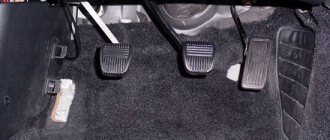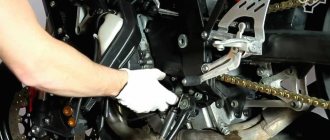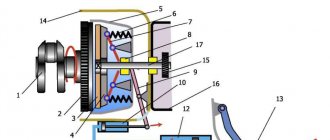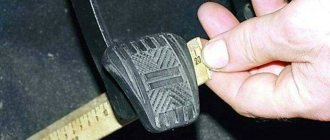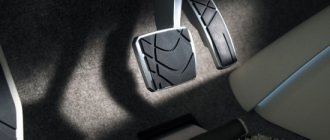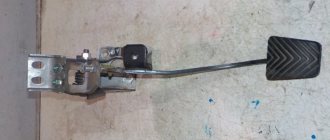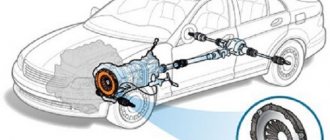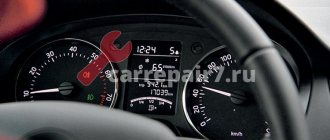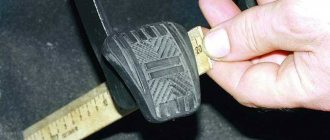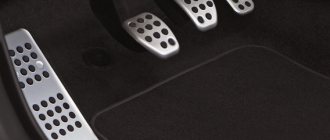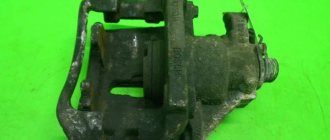Basic faults
The slave cylinder has several rubber seals, which often become unusable or become oily, causing the car’s clutch to “slip.” Replacing old seals with new ones will require using a lift or inspection hole, since the main cylinder is located in an inconvenient place.
When replacing seals, do not forget that there is brake fluid in the system; it must first be drained.
It is advisable not to touch the flare nut, otherwise additional adjustment will be required later. In order to replace the gaskets without removing the master cylinder, certain skills and experience are required.
Another cause of clutch malfunction may be wear of the release bearing. To replace it, you will have to dismantle the gearbox. Brake disc linings wear out just as often, which is easy to notice by the characteristic noise when the pedal is released. And the most common problem with a clutch malfunction is air getting into the system. Air can be removed by bleeding.
We fix problems
The following factors indicate that the VAZ 2107 clutch is starting to slip:
- unpleasant odor;
- the car accelerates hard;
- When climbing a mountain the engine lacks power.
In order to understand whether the VAZ 2107 clutch is slipping or not, you need to:
- tighten the handbrake;
- turn on the speed and begin to gently squeeze the gas, while at the same time releasing the clutch pedal;
- if the engine stalls, you can be sure that the clutch system is working properly;
- If the engine stalls and the car is moving, then we can say with confidence that the clutch of your car is slipping.
Replacing the disk
What to do in this case? First you need to check the VAZ 2107 clutches for ease of movement. Having identified problems, try to correct them by adjusting them. It is likely that the system is slipping due to worn-out clutches. In this case, you need to find out the degree of wear. If the wear is insignificant, then in order to eliminate slipping, it is enough to adjust the clutch travel. If the wear is significant, then it is necessary to replace the driven disk and linings. This is necessary if the distance between the working parts and the rivets is more than 0.2 millimeters.
Often, for various reasons, the linings become oily, mainly due to an increased level of lubricant in the gearbox or due to the fact that the flywheel drain holes are clogged. The way out of this situation is very simple: just wash the pads with a liquid like kerosene. Then all surfaces must be wiped and cleaned with sandpaper.
Clutch slipping can be caused by swollen rubber parts of the hydraulic drive. In order to prove or disprove this, you need to take the following steps:
- remove the cylinders, including the main one;
- clean the system with alcohol;
- replace swollen parts with new ones;
- thoroughly clean the expansion holes;
- add brake fluid;
- bleed the brakes.
In cars older than ten years, slipping often occurs due to hardening of the pressure springs, which ultimately weakens the pressure on the driven disk, which leads to difficulties with slipping. In order to determine the condition of the springs, you need to completely remove the clutch disc. If necessary, replace the springs or even the entire clutch.
Possible reasons for clutch pedal failure
The clutch pedal is depressed when depressed and does not return
This problem can be easily solved in stationary conditions either at a service station or with your own hands in the garage. To replace or repair the main clutch or control valve in the garage, you must have repair kits for the clutch slave and master cylinders.
Reasons for failure and non-return of the clutch pedal of VAZ2106 and VAZ2107:
How to drive a VAZ2106 or VAZ2107 without a clutch? We'll talk about this below:
The clutch pedal has failed: what to do in such a situation?
Everyone knows that the life of a car enthusiast involves constant stress. In addition to the dynamics of road traffic, which does not allow the driver to relax in principle, there are also unpleasant situations that are associated with an unexpected breakdown of a car (for example, Nissan Terrano 2014). Precisely away from home, precisely in the flow, precisely while moving.
Such troubles are standard: the clutch has disappeared and the brakes have failed. On the forums of motorists of almost all models and brands, the most common question is: the clutch pedal has failed, what to do...
There are certainly many reasons for clutch failure. It is worth trying to consider a certain list of reasons that lead to the clutch pedal not returning.
Causes of clutch pedal failure in a car
It is worth considering the causes and ways to get rid of them in a hospital setting. Either repair the clutch yourself in the garage, or at a service station. Operations such as repair or replacement of the main clutch or clutch master cylinder are completely acceptable activities in a garage, if you have a repair kit for the clutch slave or master cylinder.
For what reasons does the clutch pedal not return (“the clutch pedal fails”)?
— Clutch cable rupture in the place where the tip is sealed. This malfunction is unlikely to be fixed on the spot, although some people advise carrying a spare cable with you to replace the faulty one. But it’s problematic to constantly carry every detail and spare part with you;
— The return spring has burst or fallen off. If the spring has flown off, then it can be returned to its original place. If the spring breaks, then, as in the situation with a cable, either under its own power to the garage or service station, or in a “tug”. How to continue driving without a clutch? More on this below;
— Air has entered the hydraulic drive system. In this case, only bleeding the clutch to remove air can help;
— the clutch pedal has failed, but it is possible to turn it on for a short time only by very sharply pressing the pedal, the clutch master cylinder is to blame: wear or a defect in the clutch cuff, defects in the mirror. The problem is solved by changing the clutch master cylinder;
— failure of the clutch fork. The answer in this case is clear - it is necessary to replace the clutch fork.
How to get to a service station (service station) if the clutch is lost.
All the same, this happened - the clutch pedal failed and did not return back. Even with the help of my leg I still can’t get it back. There is heavy traffic, the middle of the day and the task is to get to the garage, car service, or at least the nearest parking lot.
If the clutch has disappeared, then there are three options: get there yourself, call a tow truck, or ask someone to pull it in tow.
The question arises, how to get to your destination if the clutch is lost. It's not easy, but it's quite possible. There are several tips that have been tested by car enthusiasts in practice.
The gear shift lever is placed in first gear.
The ignition key is turned and the gas pedal is pressed simultaneously with the engine starting, so that the 2014 Nissan Qashqai does not stall. The movement begins.
While driving, you should not try to switch to second gear, as a new gearbox will cost more than calling a tow truck.
In the same way, in principle, you can start driving in second gear.
But in this and in other cases it is worth paying attention to some important nuances: When the pedal has failed and the clutch has disappeared, you should try to stop the car either on a straight section or on a slope (descent)
But by no means uphill. If you stop on an incline, the clutchless driving method will not work.
When the pedal has failed and the clutch has disappeared, you should try to stop the car either on a straight section or on a slope (descent). But by no means uphill. If you stop on an incline, the clutch-less driving method will not work.
The engine must be warmed up before driving.
Important! Do not forget that you will have to move in first, or at most in second gear. That is why, before you start moving, you need to carefully think through the route: how many intersections, traffic lights will be on the way, in what sequence and where you will need to turn, etc.
If possible, it is worth planning a route to your destination so that you always follow the main road (so that you do not have to give way).
Leveling up
To bleed, you will need brake fluid and a container for draining it, as well as a transparent hose with a diameter of 5mm. and an assistant who will have to press the clutch pedal until heaviness appears in it. After this, it must be clamped, and at this time a second person must unscrew the fitting and drain all the brake fluid. Air bubbles will be visible in the hose. The procedure should be repeated until these same bubbles disappear. Also, do not forget about the fluid level in the expansion tank.
VAZ 2107 clutch diagram
Slipping - clutch
| Diagram of the structure and operation of the differential. |
Clutch slipping can occur due to lack of free play of the clutch pedal, oiling or wear of the friction linings of the driven disc. In this case, the torque from the engine is not fully transmitted and the car moves away very slowly or even stands still with the gear engaged and the clutch pedal released. To eliminate the malfunction, you need to check the amount of free play in the center of the clutch pedal pad, which should be 35 - 45 mm on the Moskvich-412 car and 20 - 30 mm on the VAZ-2101. If, after adjusting the free play of the pedal, the clutch continues to slip, it must be removed, washed or the driven disc linings replaced.
Clutch slipping can occur due to swelling of the rubber sealing (cuff) rings 5 (Fig. 36, a) and the rubber ring floating valve 7 of the piston 6 of the main cylinder / and clogging of the compensation hole 2 or swelling of the rubber sealing rings 12 and 14 (Fig. 36 , b) working cylinder 9 of the clutch release drive.
Clutch slipping may result from improper adjustment of the clutch drive (selection of free play of the pedal), oiling of the discs due to improper (excessive) lubrication of the release clutch bearing, or weakening of the clutch springs as a result of overheating of the clutch due to excessive slipping of the machine.
Clutch slipping can be noticed while the machine is moving, when a tractor or car operating under load does not increase its speed with a sharp increase in the engine crankshaft speed. The cause of clutch slipping may also be incorrect adjustment, as a result of which the clutch is not fully engaged. If it is caused by oily discs, the clutch should be washed in kerosene. To do this, with the engine running, turning the clutch on and off, pour kerosene between the discs.
Signs of clutch slipping are the car moving slowly and low acceleration when accelerating.
A sign of clutch slipping is when the car accelerates too slowly, despite an intensive increase in engine speed: a burning smell appears.
To eliminate clutch slipping on a MAZ-205 car, proceed as follows. Remove the inspection hatch cover (see Fig. 62, b) from the bottom of the clutch housing and measure the distance from the end of the clutch of the release levers to the plane on the clutch casing (dimension A), which should be 31 5 - 35 5 mm. If dimension A is greater than 35 5 mm, you need to remove one adjusting shim from under the restrictive crackers; if size A is less than 31 5 mm, one additional gasket with a thickness of 0 25 mm should be installed under each cracker.
Do not use clutch slip to change the speed of movement of the forklift; the speed of movement must be changed by adjusting the opening value of the carburetor throttle valve or by shifting the gearbox.
To eliminate the causes of clutch slipping, you must first check and, if necessary, adjust the free play of the clutch pedal. The free play of the pedal is measured using a ruler. And this is done as follows. First, we put a ruler and measure where the pedal platform is in a free, not pressed state. After this, we slowly begin to press on it until we feel resistance. The distance traveled by the pedal is its free play.
To eliminate the causes of clutch slipping, you must first check and, if necessary, adjust the free play of the clutch pedal (see section. If the clutch still slips during normal free play of the pedal, then you should contact a specialist at a service station. To do this, you need to unscrew the bolts 7 securing the casing 5 to the flywheel 8, having previously removed the gearbox (see section. This releases the driven disk 2 (with friction linings 1 and 3) of the clutch.
| Single disc clutch with electromagnetic drive. |
For normal operation of the car without significant slipping of the clutch when it is engaged, the clutch torque Mc must exceed the engine torque Mc Mtmax.
| Checking the clutch pedal free play. |
Insufficient free play causes clutch slipping (incomplete engagement) and rapid wear of the friction linings and clutch release bearing. If the free play of the pedal is large, the clutch will not disengage completely.
How to get to the nearest service station or home if the clutch pedal has failed?
The task, although not easy, is still quite realistic. The main thing here is to get going and not take your foot off the gas, maintaining the speed in first gear.
You need to proceed as follows
We warm up the engine, turn on the emergency lights, then turn on first gear, and turn the key in the ignition. When the engine starts to “catch”, give the gas and start moving. With the right approach, the car will not stall, and you will be able to move away and slowly get to your destination. Don't try to change gear without a clutch - it is certainly possible, there is a technique, but without the proper skill you will most likely stall or damage your transmission.
Now you know why the clutch pedal does not return, for what reasons this happens and how to solve this problem. In addition, if this happens, you will know how to get home if the VAZ clutch pedal fails. That's all for me, write in the comments how you solved this problem and what signs of malfunction you had and the cause of the breakdown. Thank you all for your attention and see you again at VAZ Repair. Bye.
Clutch fails: causes and repairs
The manual transmission is simple, reliable and has a long service life. At the same time, the manual transmission clutch is considered to be a “consumable” with a rather limited service life. Moreover, if you actively load the car, make mistakes when working with the clutch and operate the car in difficult conditions, individual clutch elements may fail by 60-80 thousand km. mileage on a new car.
As a rule, quite often owners of cars with a manual transmission encounter a malfunction when the clutch pedal fails. The reasons for such a breakdown may be different, since a manual transmission is a unit consisting of a large number of parts and mechanisms. Next, we will look at why the clutch pedal disappeared, as well as what to do if the clutch fails.
Read in this article
How to finally adjust the clutch on a VAZ 2107
After all manipulations, it is necessary to check the functionality of the system. To do this, you need to start the engine and let it warm up. Then, with the engine running, you need to depress the clutch and, without accelerating, engage the rear rocker position. In this case, the presence of extraneous sounds and rattles is not allowed. The position is turned on easily - without additional effort.
Next, you can start moving at first speed and then increase the position to maximum (5). When driving, the presence of extraneous sounds or grinding noises is strictly unacceptable; the pedal is pressed evenly, without dips or jerks.
The last stage is acceleration at each gearbox speed, while the set of engine speeds fully corresponds to the acceleration of the car. If there is dissonance, the clutch disc slips and recalibration is required.
Methods for solving the problem
If the clutch pedal fails while driving a car, then there are not many ways to solve the problem. We recommend that you familiarize yourself with all the methods so that in the event of a corresponding breakdown you know how to behave.
Replacing the cable
To replace the cable, you will need the cable itself, as well as wrenches and pliers. It is advisable to use a spanner or open-end wrench, this will be much more convenient.
But if you don’t have a box and open-end wrench on hand, you can also use a regular wrench:
- Open the hood of your car. In the engine compartment you need to find the very place where the cable is attached to the tip. Since a break occurred, most likely the tip remained in the installation location, and the cable itself was dangling. You need to remove the tip using a wrench.
- Then get inside the car and disconnect the cable directly from the clutch pedal. Remove the cable.
- Take the new cable and install it in place of the old one, the entire assembly occurs in the reverse order.
- You need to measure the free code of the pedal, and then adjust the installed element. The free play should be no more than 3 cm, and the total should be no more than 14.7 cm. The accelerator travel is adjusted using the nuts on the end of the cable in the engine compartment.
1. Unscrew the fastening nuts
2. Remove the locking bracket
3. Adjust the new cable
We recommend: How can you reduce fuel consumption on a VAZ-2114?
If the spring breaks
If the return spring bursts, the procedure will be different. To replace, you will need the spring itself; if you do not carry it with you, you will have to go to the nearest spare parts store.
How to change a spring:
Open the hood and use a wrench (it’s more convenient to use a spanner) to unscrew the cable nut
You need to extract it. Carefully, so that the remains of the old return spring do not fall apart, remove them. Please follow all safety rules. Take the new part and install it in place of the old one
This also needs to be done carefully, since in this case it is very easy to damage your hand or fingers. Then reinstall the cable. Tighten the nut. After this, adjust the free and overall travel of the pedal. Start the engine and try to drive it.
1. Unscrew the fastening nut.
2. Remove the spring and replace it with a new one
How to get to the service station on your own?
Of course, it will be better for the driver if this breakdown occurs near his home, then you can consider yourself lucky. But if this happened on the road, and the nearest service station is not so close that you could push the car to it, then this is already a problem. But there is a way out of every situation, so if the clutch pedal fails, you can still get to the nearest service station, and now we’ll tell you how.
To drive in first gear - if you need to restore the pedal's functionality, you can do the following:
- The gearshift lever must be moved from neutral to first gear. In this case, the gas must be released.
- Start turning the key in the ignition. When the engine tries to start, apply gas, but do it so that the car does not stall.
- When the car starts to move, do not try to change to the next gear. This is fraught with breakdown of the gearbox, and its repair, believe me, will cost more than calling a tow truck.
In general, the same method allows you to start moving at second speed.
But before you do this, check out some important points:
- When the pedal fails, do your best to stop the car on a downhill slope or on a straight road without the car rolling backwards.
- Warm up the engine before driving.
- Before you start moving, carefully consider your entire route, because you need to take into account all the nuances. This includes the number of intersections, traffic lights, where you should turn from and where, and so on. It will be more convenient to drive only on the main road, so that you don’t have to stop to let other cars pass.
- Turn on the warning lights (hazard warning lights).
- Avoid unnecessary maneuvers and remember that no one knows about this problem except you. It’s better to stop once again and repeat the procedure than to create more serious problems for yourself.
- If you are not sure that you can cope with such a task on your own, then maybe it makes sense to call a tow truck or tow the car to a service station?
Clutch mechanism of VAZ 2107
The VAZ 2107 clutch is a rather complex mechanism consisting of several dozen elements. The reasons for its malfunction can be very different. However, they can all be divided into two groups:
The clutch, like any other car part, has a limited service life. First of all, it depends on the skill of the driver, and therefore is not regulated by the manufacturer. To increase the service life of the clutch, it is necessary to adjust it in time, monitor the level of working fluid, avoid off-road driving, and learn the skills of using the clutch correctly.
It must be remembered that in addition, the clutch is a safety device that protects the transmission from serious damage when the rear wheels are blocked by various obstacles. The car is stuck in a quagmire, the drive wheels are stuck, the engine power is enough to turn the stuck tires. In this case, the clutch will begin to slip, protecting the gearbox, cardan and rear axle from damage. Yes, the driven disc linings will burn out. Yes, the clutch will overheat, which can cause the steel flats to warp or weaken the spring plates. But more expensive units will be protected from breakdowns.
Classic VAZ models have a dry, permanently closed single-plate clutch . It includes two main elements:
Classic VAZ models use a single-disc dry, permanently closed clutch: 1 - flywheel; 2 — clutch driven disc; 3 — clutch basket; 4 — release bearing with clutch; 5 — hydraulic clutch reservoir; 6 - hose; 7 — master cylinder of the hydraulic clutch release; 8 — servo spring of the clutch pedal; 9 — clutch pedal return spring; 10 — clutch pedal travel limit screw; 11 — clutch pedal; 12 — hydraulic clutch release pipeline; 13 — ball joint fork; 14 — clutch release fork; 15 — release spring for clutch release fork; 16 - hose; 17 — working cylinder of the hydraulic clutch release; 18 — clutch bleeder fitting
What is the clutch mechanism?
The VAZ 2106 and 2107 have a dry type of clutch with one disc, which operates as a closed mode. The spring mechanism is located in the center, the vibration damping device is located on the driven disk. This unit is a non-separable mechanism with a protected housing, inside of which there is a push-type clutch disc and a diaphragm spring.
The protective housing is attached to the flywheel using special bolts and dowel pins. The clutch disc is connected to the protective part of the housing through three pairs of steel plates. The clutch basket of VAZ 2106 and 2107 is connected to the outer part of the diaphragm spring by means of locking fasteners. The spring is held on two rings attached with rivets to the protection body. The clutch disc is made of steel and has 12 sectors with driven slots.
Friction linings are connected to the sectors separately from each other. In the gear shift mechanism of VAZ 2106 and 2107, the damper, which is located between the driven disk and the hub, performs the function of attenuating passive torsion pulses.
The hydraulic mechanism includes the main and clutch master and slave cylinders, the clutch fork, the release bearing, the fluid reservoir, and the clutch foot pedal with a spring. Safety on the road while driving depends on the reliability of this mechanism. Therefore, it is necessary to promptly check the fluid level in the tank and the condition of the cable.
At the first signs of a sticking clutch pedal, you should perform preventive diagnostics of the elements of the vehicle’s clutch system so that you do not have to apply this knowledge in practice.
Replacing the clutch yourself
When replacing the clutch, you should carefully inspect all the parts being removed; it is quite possible that you will not need to replace the entire assembly; it will be enough to change only some parts.
The clutch is replaced in the following sequence:
When assembling, all parts must be thoroughly washed, but under no circumstances should this be done in gasoline or oil. Lubrication is carried out only with brake fluid.
The clutch is one of the most important components in a car, without which it simply will not move. Therefore, this complex system requires proper attention and care. Malfunctions in the clutch operation can lead to spontaneous movement of the car, and this is a direct threat to the lives of others.
The clutch pedal has failed: what to do in such a situation?
Everyone knows that the life of a car enthusiast involves constant stress. In addition to the dynamics of road traffic, which does not allow the driver to relax in principle, there are also unpleasant situations that are associated with an unexpected breakdown of a car (for example, Nissan Terrano 2014). Precisely away from home, precisely in the flow, precisely while moving.
Such troubles are standard: the clutch has disappeared and the brakes have failed. On the forums of motorists of almost all models and brands, the most common question is: the clutch pedal has failed, what to do...
There are certainly many reasons for clutch failure. It is worth trying to consider a certain list of reasons that lead to the clutch pedal not returning.
Causes of clutch pedal failure in a car
It is worth considering the causes and ways to get rid of them in a hospital setting. Either repair the clutch yourself in the garage, or at a service station. Operations such as repair or replacement of the main clutch or clutch master cylinder are completely acceptable activities in a garage, if you have a repair kit for the clutch slave or master cylinder.
For what reasons does the clutch pedal not return (“the clutch pedal fails”)?
— Clutch cable rupture in the place where the tip is sealed. This malfunction is unlikely to be fixed on the spot, although some people advise carrying a spare cable with you to replace the faulty one. But it’s problematic to constantly carry every detail and spare part with you;
— The return spring has burst or fallen off. If the spring has flown off, then it can be returned to its original place. If the spring breaks, then, as in the situation with a cable, either under its own power to the garage or service station, or in a “tug”. How to continue driving without a clutch? More on this below;
— Air has entered the hydraulic drive system. In this case, only bleeding the clutch to remove air can help;
— the clutch pedal has failed, but it is possible to turn it on for a short time only by very sharply pressing the pedal, the clutch master cylinder is to blame: wear or a defect in the clutch cuff, defects in the mirror. The problem is solved by changing the clutch master cylinder;
— failure of the clutch fork. The answer in this case is clear - it is necessary to replace the clutch fork.
How to get to a service station (service station) if the clutch is lost.
All the same, this happened - the clutch pedal failed and did not return back. Even with the help of my leg I still can’t get it back. There is heavy traffic, the middle of the day and the task is to get to the garage, car service, or at least the nearest parking lot.
If the clutch has disappeared, then there are three options: get there yourself, call a tow truck, or ask someone to pull it in tow.
The question arises, how to get to your destination if the clutch is lost. It's not easy, but it's quite possible. There are several tips that have been tested by car enthusiasts in practice.
The gear shift lever is placed in first gear.
The ignition key is turned and the gas pedal is pressed simultaneously with the engine starting, so that the 2014 Nissan Qashqai does not stall. The movement begins.
While driving, you should not try to switch to second gear, as a new gearbox will cost more than calling a tow truck.
In the same way, in principle, you can start driving in second gear.
But in this and in other cases it is worth paying attention to some important nuances: When the pedal has failed and the clutch has disappeared, you should try to stop the car either on a straight section or on a slope (descent)
But by no means uphill. If you stop on an incline, the clutchless driving method will not work.
When the pedal has failed and the clutch has disappeared, you should try to stop the car either on a straight section or on a slope (descent). But by no means uphill. If you stop on an incline, the clutch-less driving method will not work.
The engine must be warmed up before driving.
Important! Do not forget that you will have to move in first, or at most in second gear. That is why, before you start moving, you need to carefully think through the route: how many intersections, traffic lights will be on the way, in what sequence and where you will need to turn, etc.
If possible, it is worth planning a route to your destination so that you always follow the main road (so that you do not have to give way).
What to do if the gear shift mechanism does not work?
If the clutch pedal fails on a road with heavy traffic, you should not be nervous, but act calmly with a “cool head” and get to the nearest parking spot, or even better, to a garage or service station. To do this, you can use a tug, tow truck, or drive yourself.
How to drive independently if the clutch system breaks down?
You can use the following tips from proven car enthusiasts:
You can also drive to the repair site with a VAZ2106 or VAZ2107 car without a clutch, engaging second gear in the same way when starting to drive. Only in this case it is necessary to take into account some important nuances:
In VAZ cars with a rear-wheel drive wheel pair, the clutch mechanism is a separate hydromechanical unit that interacts between the power plants and the transmission.
The clutch has fallen: why does the clutch pedal fail?
Let's start with the fact that such a malfunction, when the clutch is lost, can happen completely unexpectedly. To accurately identify the problem, it is important to know why the clutch fails and what to do in such a situation.
In a nutshell, the clutch is necessary to “disconnect” the engine from the transmission in order to be able to engage and disable gears, and also allow the car to run at idle.
First of all, the clutch pedal usually goes down for the following reasons:
- The return spring is faulty. Said clutch return spring creates resistance that pushes the pedal back after the driver stops pressing it. Simply put, by removing your foot from the clutch, the pedal should return to its original position on its own. If the spring has burst, shifted or is extremely worn, then the clutch pedal may not return or may become stuck. To fix the problem, you need to disassemble the return mechanism and change the spring;
- The clutch cable has broken (the clutch cable has burst/broken), the fastening of the clutch cable tip has broken. In this case, the clutch cable needs to be changed;
The next problem on the list is the failure of the clutch fork. As a rule, the specified fork needs to be changed, since it actively wears out and is then damaged during operation;
Please note that if clutch failure occurs due to problems with the master cylinder, the functionality of the clutch pedal can be partially restored by pressing it sharply. This method is suitable as a temporary solution to get to the repair site.
However, it is not recommended to drive for a long time in this way, as this can result in other damage. For this reason, the owner of a car with a manual transmission must know how to drive without a clutch, how to engage a gear (speed) without a clutch, etc. Such skills allow you to combine available methods, which makes it possible to minimize the risks of additional malfunctions when driving with a faulty clutch.
What actions should be taken if the clutch slips?
The most rational and correct solution is to replace the clutch, but before that, you need to get to the garage. This must be done with extreme caution. To avoid problems, you need to drive with the lowest number of revolutions. It is necessary to start moving “under load”. This means that the clutch needs to be released as smoothly as possible, but at the same time add a minimum of gas, or even not at all. Gear shifting should be performed according to the number of revolutions prescribed by the manufacturer.
What to do if the clutch slips?
The normal service life of clutch system discs is about 70 - 85 thousand kilometers. A quiet ride, without “pressing into the seat” acceleration, as well as frequent gear changes, helps increase their resource intensity. On the contrary, a “sporty” start and frequent driving with a trailer (both options are acceptable for the VAZ 2107) can wear out the coupling mechanism prematurely.
All complaints about the malfunction of the coupling mechanism come down to two groups:
The clutch does not disengage completely (drives) - the pedal travel is long, tighter than necessary, gears are engaged, and a crunching sound is heard during shifting.
The clutch does not fully engage (slips) - the opposite situation, then there is insufficient pedal travel, slipping in the discs even if the pedal is completely free and released..
How to determine if the clutch is not fully engaged?
It's easy to do it yourself. We start the engine, put the gearshift lever in the neutral position, and fully tighten the handbrake. After this we “gas”. Then fully depress the clutch and engage first gear. If the clutch operates correctly, there should be no difference in sounds on the VAZ 2107. Now slowly release the pedal. If the clutch works well, the engine will stall. If it continues to operate even though the pedal is fully released, the clutch is slipping.
Why does the clutch slip and what should I do? Let's take a closer look at what these situations are and how to avoid them. The reasons are most often the following:
- oil getting into the clutch: on the friction linings of the driven disc, on the surface of the flywheel or pressure plate (most often in the VAZ 2107 - leaking crankshaft rear oil seal, high oil level in the gearbox housing, poorly lubricated bearing on the gearbox shaft, clogged drain hole on the flywheel shaft and etc.). In this case, the clutch slips because only the dry part of the linings works. After eliminating the causes, you need to thoroughly wipe the parts that got oil on them with gasoline or white spirit, and clean the friction linings with sandpaper after drying.
- The friction linings of the clutch discs are severely worn down to the rivets. In this case, the free play of the pedal decreases. When inspecting the gaskets, it is also necessary to replace them if they are cracked or burned out.
- The pressure springs have failed. If they have lost their elasticity, then they are unable to create sufficient pressure on the disc. In this case, they are replaced;
- no gaps in the clutch release drive
- small free play of the clutch pedal. To determine the amount of pedal displacement, take a ruler and measure the amplitude of the displacement at the center of the pedal pad. Normally, the VAZ 2107 should have a range from 25 to 35 mm
Once you have determined the reason why the clutch mechanism is slipping and have eliminated it, you need to adjust the clutch drive.
- We take an open-end wrench, they need to unscrew the M 10 nut in the interior, which limits the play of the pedal. To do this, we turn the limiting device (it is marked with the letter A), then you need to set the desired gap.
- We free the clutch pusher belonging to the cylinder from all kinds of dried dust and generously spray WD-40 on the threaded area.
- Do not forget that whatever the size of the reach stroke, the same exact absolute length will occur synchronously on the release bearing. To check this, pull the coupling fork completely backwards with your own hand. At the same time, the free release of the coupling pusher is normally about 4.5 mm in the VAZ 2107.
- To adjust the pusher play, use a 17 mm open-end wrench to stop the pusher adjustment nut from turning, and use a 13 mm wrench to “give slack” to the lock nut.
- To set the free play of the pusher, use a 17 mm wrench to fix the adjusting nut, and at the same time loosen the lock nut using a 13 mm wrench.
- Holding the clutch mechanism pusher from the threat that it will turn, using a small 8mm wrench, using a 17 mm open-end wrench, turn the nut to adjust and set the free reach of the pusher in the range from 4 to 5 mm.
- Now, using one wrench, we hold the adjustment nut, and with the other, we tighten the lock nut.
- Now in the cabin we again measure the travel of the clutch pedal. In normal condition on a VAZ 2107, it should be equal to 2.5 cm to 3.5 cm from the uppermost position until the start of shutdown.
Low gearbox oil level
An insufficient amount of oil in the box makes the process of shifting gears extremely difficult, but the speeds must be engaged. When switching in this way, a metallic crunch is heard, and when driving in a gear, the transmission begins to make a lot of noise and “howl.”
A complete lack of lubrication in the gearbox will not allow you to change gears, since without oil the synchronizers will not be able to work properly, and the gears in the gearbox will not engage.
Any manifestation of these symptoms requires immediate cessation of operation of the vehicle and checking the transmission oil level in the gearbox. It is also necessary to inspect the gearbox for damage to the housing, oil leaks through the seals and gaskets.
It should be noted that for manual transmissions of many cars, the oil in the gearbox is filled from the factory for the entire service life. In practice, replacement is recommended every 60-80 km. mileage
It is imperative to fill only with lubricant recommended for viscosity and other characteristics. As for adding oil to the transmission, it is necessary to separately take into account the issue of compatibility with the already filled lubricant.
Causes of clutch slipping
There may be several reasons causing this effect. As a rule, they arise due to a characteristic driving style, which is commonly called sporty. Sharp acceleration and braking, frequent gear changes significantly reduce the working life of the clutch, although AvtoVAZ defines it as 75-85 thousand kilometers. In addition, experts say that the performance of a car’s clutch can be significantly affected by the use of trailers. It is believed that they are capable of significantly shortening the life cycle of components and mechanisms of an automotive element. Let's look at the most common actual causes of clutch slipping.
Choose the best
The last point in the question of which clutch is best to install on a VAZ 2107 car will be a short review of the most famous clutch kits for classic cars. Differences in brand products lie in reliability and behavior during operation.
Valeo
The well-known company from France is also known for its high-quality brake pads. Judging by the reviews of car owners, the clutch is characterized by soft operation with a clear engagement moment.
Many note the reliability of the new Valeo kits, which often operate without breakdowns for more than 150,000 km. The disadvantage is the high cost.
World famous German manufacturer of friction clutches. The products have always been distinguished by advanced design solutions. For example, the use of a torsional vibration damper on the pressure and driven discs significantly dampens vibrations, which contributes to comfort. LuK couplings are the best choice in terms of price-quality ratio, however, there are many fakes on sale, so you need to be careful when purchasing.
Kraft
The German brand has been known for 20 years, but recently products under this brand are increasingly being produced in Turkey, which, naturally, makes them cheaper. However, clutches have a lot of positive reviews, including:
Sachs
The German manufacturer has extensive experience in the production of transmission parts. All coupling models are equipped with asbestos-free linings, and they provide:
A domestic enterprise that supplies original products for Lada cars. The design of the coupling was developed by engineers from Tolyatti, but the components used in production are mainly imported. Most car owners, when deciding which clutch is best to install on the classic VAZ 2107, choose this manufacturer. The reason for this choice is the low price and acceptable quality.
Kraft tech
Turkish products licensed from the German company Kraft. The set is characterized by soft operation and is adapted to Russian working conditions. Some of the negative reviews relate to the fragility of the release bearing.
Why is clutch needed?
The clutch is necessary to transmit torque from the engine flywheel to the intermediate shaft of the vehicle's gearbox. This is exactly the part that can limit or create the connection between the power plant and the transmission. The principle of operation of the clutch is based on the friction that occurs between two pressed discs. When you press the clutch pedal, the disc is released and the transmission of torque stops. When released, the disk is again pressed against the flywheel and then the intermediate shaft of the gearbox comes into operation.
